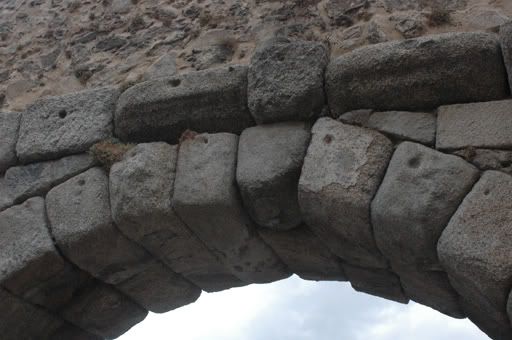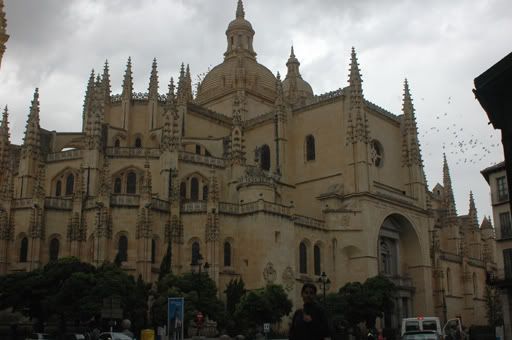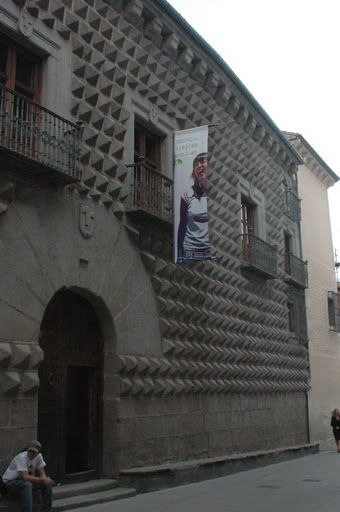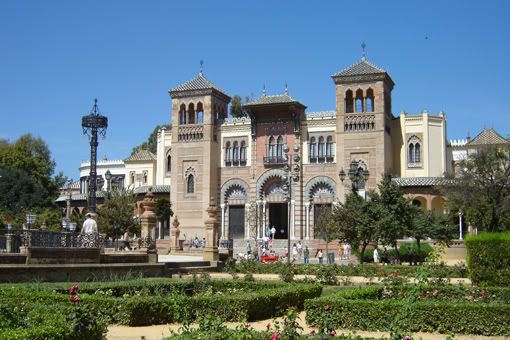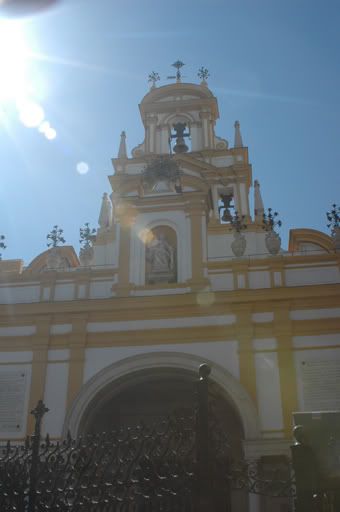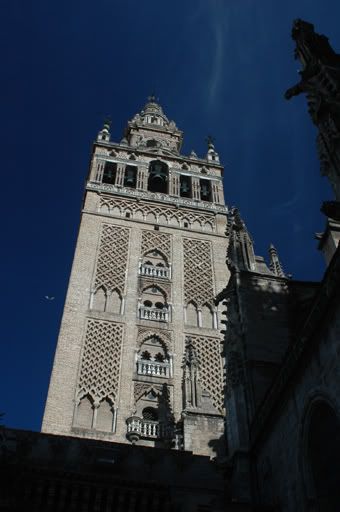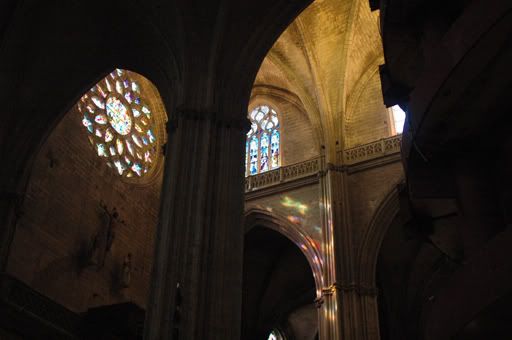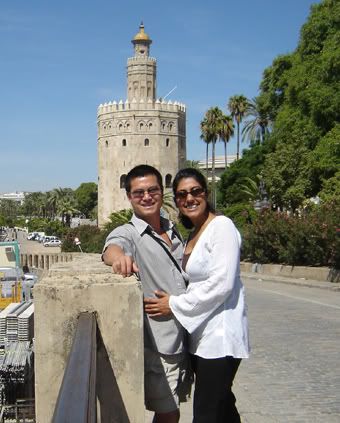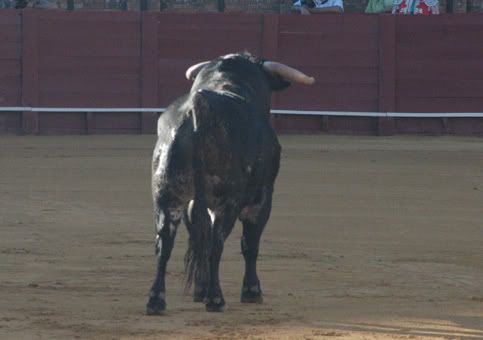With a wonderful three days in a city that we thought summed up Spain in a nutshell, we were eager to get to Madrid to see what the capital city had to offer. If it was anything like Seville or Barcelona, we knew we had lots in store.
We took a 3 ½ hour train ride to Madrid and arrived bright and early to clear and sunny skies. We made our way via metro to the area around the Puerta del Sol (known as Kilometer Zero; the city’s physical and emotional heart and the major artery through which all main streets stem off of) and got off at the Grand Via stop, a 5 minute walk to Puerta del Sol. Chris parked himself in the shade while I started the search for a place to stay. We had read about a Hostel Orly in the Lonely Planet and were hoping to get a room there if possible as it seemed to have a good recommendation and was “cheap” for big city standards. As soon as we stepped out from the metro though, the hot temperature and blaring sun made me forget about this hostel for a moment and made me want to duck into the first few that hit my path. The first hostel I came across was a few steps away from the metro station and they were fully booked for the next few nights. I was ready to start the trot down this street in search of another hostel when I realized that the hostel we were reading about in the Lonely Planet was in the same building that I had just been in but on the 7th floor. I climbed the seven flights of stairs since the elevator was not working and was hoping the trek up to this place was worth it. As soon as I rang the bell and saw the smiling face of a dear old lady answer, I knew this would be the place.
She quickly showed me a double room with a private bathroom which was GREAT!! It was clean, very large, bright and on top of that had a balcony overlooking Grand Via street, one of the main streets in Madrid and was only for 45 Euros a night. I gladly took the room for two nights and went down to grab my man and the baggage.
The usual write up at this point would entail a LONG write up on how great Madrid was, what we saw and what we did. Well I hate to disappoint you all but it’s not going to happen for this city.
Madrid was nothing like we had hoped or thought it would be. Perhaps it was because we were spoiled by what Seville had to offer or we had too many expectations of a big city since we thoroughly enjoyed ourselves in Barcelona. Either way, both Chris and I were rather disappointed by Madrid. There is not much to see here (except for the Prado Museum that has some beautiful displays of artwork and a couple others if you are into modern art), the people are not that friendly and the city just seemed to have a “blah” feeling to it all. There are of course some interesting and beautiful buildings such as the Palacio Real and the Royal Basilica but nothing that seemed too really blow us away. We had heard that Madrid was known for its night life so perhaps the all night drinking and dancing in the clubs and bars is what makes Madrid so popular for some but for us “oldies” who are not into that scene anymore, it was a bit of a letdown. Add to this, the prostitution that was quite evident on Calle Montera and you can start to understand where we are coming from. Chris and I were very surprised when we found out that these prostitutes were “working” on the street that our hostel was on. These young girls were dressed in normal everyday clothes and just hanging out on the street when we walked by them at 11am (yes, you read that right, eleven in the morning) so we figured they were waiting for their friends or for the bus but when we saw the same girls, in the same clothes standing in the same spots when we walked by again at midnight, we figured they weren’t waiting for the bus after all!! Although you would think this would make this street feel unsafe, it really didn’t. It was always busy with tourists and locals shopping in the numerous shops along this street and making their way between the Grand Via and the Puerta del Sol. These girls seemed to be more like permanent fixtures on the street just like the street lamps and fire hydrants.
We spent 2 nights and three days in Madrid….three too many for us. The only reason we stayed that long is because we had already booked our reservations for our overnight train to Lisbon for the 21st on the first day we had arrived in Madrid thinking we would need at least three days to explore this city. Boy, were we ever wrong. Of course this is just our opinion of Madrid but that does not necessarily mean that Madrid is not a place to visit or see. Every traveller has different experiences and different views on places and like I said before, perhaps others would find Madrid a delight. Each to their own…we are just portraying the Madrid we saw and experienced through our eyes.
The only ray of sunshine that perhaps will make our visit to Madrid a bit better will be our short day trips to some of the smaller cities close to Madrid such as Segovia, Cuenca and Toledo and the possibility of getting tickets to a Real Madrid soccer match that is taking place on the 26th of Sept. Attempting to get tickets has been quite the feat and is perhaps another reason why Madrid has left a sour taste in our mouths. We attempted to buy tickets from the stadium the first day we arrived in Madrid (as instructed by the tourist information office, which by the way is not that useful at all) but the stadium advised us that they do not sell tickets there until the day before the match and only sell them via phone starting the 20th. We then attempted to phone them first thing on the 20th to charge the tickets to our credit card and were then told that they do not accept international credit cards and only accept credit cards issued from Spain…oh boy, lets just say Chris was not a happy camper. We then attempted to buy them online as instructed by another tourist information office, which we thought might be more helpful…NOT. After being told we could buy them online, we went to the internet where again we were denied, they were asking us for a 4 digit PIN number to our credit card, which of course we don’t have in Canada. So it’s safe to say, if we don’t get tickets on the 25th when we return to Madrid…our image of Madrid will be even further worsened! Cross your fingers for us…(and yes, for those of you who know me, your toes as well!)
Tomorrow we are off to a small town north of Madrid before boarding an overnight train to Lisbon, Portugal. Let’s hope Segovia is a treat.
Signing off…
Ravy the Roamer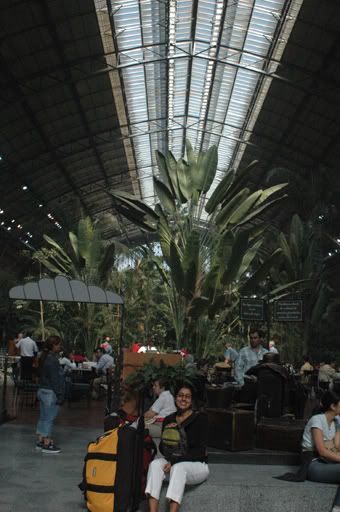 The inside of the Atocha train station – we had just arrived and were eager to see what Madrid had in store for us
The inside of the Atocha train station – we had just arrived and were eager to see what Madrid had in store for us The façade of the Royal Basilica
The façade of the Royal Basilica Interior of the Royal Basilica
Interior of the Royal Basilica Interior dome of the Royal Basilica
Interior dome of the Royal Basilica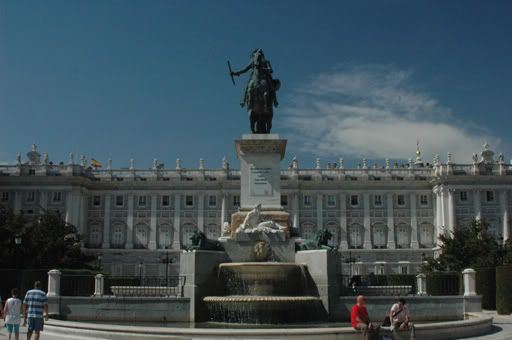 The Palacio Real, Madrid’s 18th century Bourbon palace
The Palacio Real, Madrid’s 18th century Bourbon palace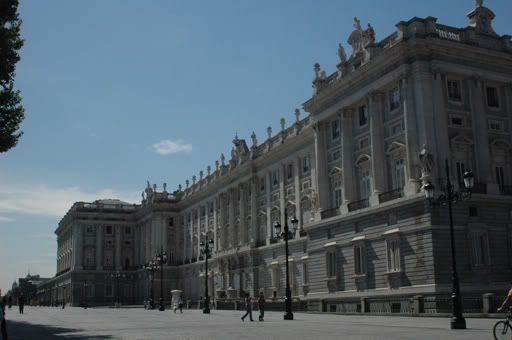 Another shot of the Royal Palace, today it is used by the king for state occasions only
Another shot of the Royal Palace, today it is used by the king for state occasions only An apartment building across from the Royal Palace
An apartment building across from the Royal Palace The view of Grand Via street from our balcony at Hostel Orly – we would definitely recommend this as a place to stay for anyone visiting Madrid – reasonably priced and the dear old lady that runs the place is a sweetheart
The view of Grand Via street from our balcony at Hostel Orly – we would definitely recommend this as a place to stay for anyone visiting Madrid – reasonably priced and the dear old lady that runs the place is a sweetheart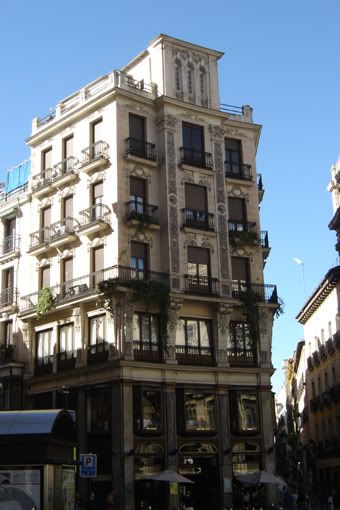 We found random buildings like this one more attractive than some of the more monumental ones
We found random buildings like this one more attractive than some of the more monumental ones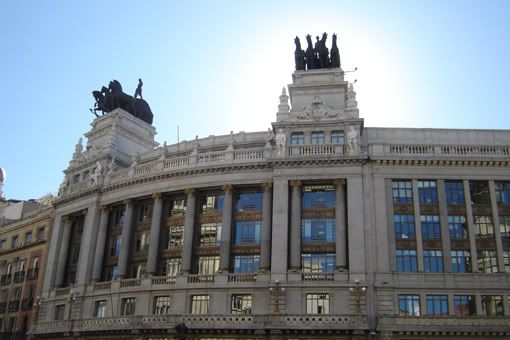 And another one…
And another one… Bear and strawberry tree which can be found in the Puerta del Sol and is the symbol of Madrid
Bear and strawberry tree which can be found in the Puerta del Sol and is the symbol of Madrid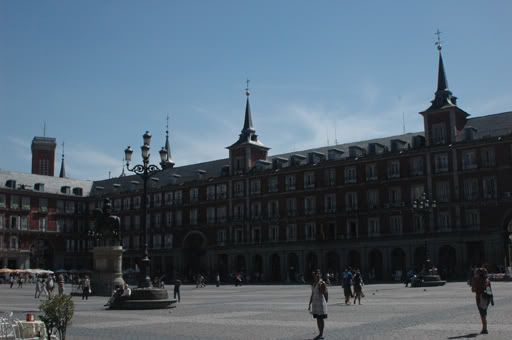 Mayor Square – a large square lined with many restaurants which reminded us of the Placa Real in Barcelona – unfortunately this square didn’t have a quarter of the life and enthusiasm that Placa Real had
Mayor Square – a large square lined with many restaurants which reminded us of the Placa Real in Barcelona – unfortunately this square didn’t have a quarter of the life and enthusiasm that Placa Real had Now this was an impressive building more so because it is Madrid’s Post Office….a lot different from what our post offices back home look like
Now this was an impressive building more so because it is Madrid’s Post Office….a lot different from what our post offices back home look like Now these are what you call HAM HOCKS Gurj!! (hehe)
Now these are what you call HAM HOCKS Gurj!! (hehe)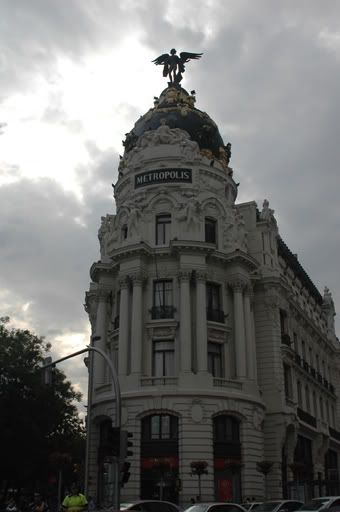 Again a building you wouldn’t necessarily think would be this well built – the Bank of Spain
Again a building you wouldn’t necessarily think would be this well built – the Bank of Spain When all else fails, a brewskie and some tapas are bound to help – sitting or standing at a bar like this is common in Madrid where the tapas are actually given to you for free to sample while you order a drink and then larger portions of the tapas can be ordered if wanted (something we didn’t realize until we hit one of these places and realized the locals would just keep ordering beers and keep getting small portions of tapas for free)…this, we can deal with!!
When all else fails, a brewskie and some tapas are bound to help – sitting or standing at a bar like this is common in Madrid where the tapas are actually given to you for free to sample while you order a drink and then larger portions of the tapas can be ordered if wanted (something we didn’t realize until we hit one of these places and realized the locals would just keep ordering beers and keep getting small portions of tapas for free)…this, we can deal with!!


